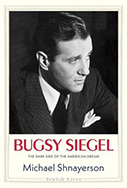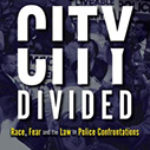Bugsy Siegel: The Dark Side Of The American Dream

Author: Michael Shnayerson
Publisher: New Haven, CT: Yale University Press, 2021. 226p.
Reviewer: Larry Gragg | August 2021
Michael Shnayerson, a contributing editor for Vanity Fair, has published books on a wide range of subjects including New York Governor Andrew Cuomo, art dealers, drug-resistant bacteria, the Hamptons, the coal industry’s challenge to the environment of West Virginia, and Harry Belafonte. He now has written a biography of Benjamin “Bugsy” Siegel for the Jewish Lives series published by Yale University Press. As one would expect from a veteran author, his account of Siegel’s life is a lively read. In several passages Shnayerson offers vivid word pictures of the young gangster. For example, when describing Siegel’s love of the night life in New York City in the 1920s, Shnayerson explains that Siegel “went out garbed in well-cut suits, with the colorful ties and monogrammed shirts of a dandy, fending off the winter chill with a hard-shelled derby hat and a velvet collared, full-length cashmere coat” (16). On occasion, Shnayerson also ventures into some intriguing conjecture. In describing Siegel’s early years, he writes “one indelible memory of childhood was the ceaseless, metallic thrum of trolley and subway traffic on the Williamsburg Bridge” (4). While it added to the texture of his story, Shnayerson has no source for this assertion about Siegel’s youthful memories. Still, anyone who is unaware of the life of this gangster, born on the Lower East Side in New York City, will likely find Shnayerson’s biography to be an engaging introduction.
The author chronicles the immigration of Siegel’s parents, his rise from street gangs to the upper echelons of the New York mob during Prohibition, his move to Southern California where he embraced Hollywood and its many opportunities to profit from legal and illegal gambling, his effort to become legitimate through the construction of the fabulous Flamingo Hotel and Casino in Las Vegas, and his murder in 1947.
Along the way, Shnayerson provides the most thorough explanation to date of Siegel’s parents’ migration to America in 1900 and their life on Cannon Street on the Lower East Side, establishes that they were Orthodox Jews, and includes a clear description of the complex FBI investigation of the gangster in 1946. Through wire taps, informants, and the surveillance of a team of agents, the FBI investigated the possibility that Siegel was bribing officials to permit him to complete the Flamingo in violation of the federal Civilian Production Administration’s ruling that banned commercial enterprises not under construction by March 26, 1946. This ban had been enacted to ensure that construction material could be diverted to build homes for returning veterans. Taken together, in this reviewer’s opinion these contributions only marginally add to what is already known about Bugsy Siegel.
More importantly, Shnayerson’s fundamental argument for his book seems to actually undercut the value of its contribution. Drawing upon the work of Malcolm Gladwell and James O’Kane, Shnayerson argues in the Prologue, “Siegel’s story is compelling on its own. But it laces through a larger one, a generational story of eastern European Jewish immigrants in the early to mid-twentieth century who found the doors of their new world closed and so, as gangsters, pursued their own dark version of the American dream” (x). Six pages later, determined that his readers not forget this theme, Shnayerson explains that this “biography is meant to keep Bugsy’s memory and importance alive, as a testament without judgment that a century ago, a small band of immigrant Jews did what they had to do to succeed in a harsh new world” (xvi). This thesis suggests that their poverty and the widespread anti-Semitism of the era foreclosed legitimate avenues of success for men, like Seigel, who thus ended up as part of organized crime.
To the contrary, scholars like historian Robert Rockaway, biographer Robert Lacey, and political scientist Peter Lupsha have persuasively shown that gangsters like Siegel made a rational choice for a life of crime. For example, while his siblings became a dentist, a pharmacist, and a rabbi, Louis “Lepke” Buchalter became the leading labor racketeer in New York City and one of the heads of the notorious Murder Incorporated in the 1930s. Rather than a “suckers’ life,” men like Siegel and Lepke wanted money and power and were unwilling to pursue success through legitimate means, unlike the vast majority of first and second-generation immigrants who did so.
While Shnayerson is on comfortable turf in describing Siegel’s early years on the Lower East Side, his exploits during the Prohibition years, and his lifestyle in Southern California, the author’s account of Las Vegas has problems. Three examples illustrate. He focuses upon the downtown El Cortez Hotel because Siegel briefly was a part owner. In noting its opening in 1941, he claims “[i]t had colorfully lit landscaping, replete with a man-made waterfall” (86), when it actually had neither. The Flamingo opened its casino in 1946 and its hotel in 1947. In describing the successful hotels that preceded it, Shnayerson includes the El Cortez and El Rancho Vegas, but not the larger, more successful Hotel Last Frontier which opened in 1942. Shnayerson argues that in 1947 Siegel was angry with associate Moe Sedway because Sedway intended to run for the Nevada State Assembly. What really angered Siegel was Sedway’s actual run for a seat on the Las Vegas city commission. The author could have avoided these and other errors by consulting the excellent body of work done on Las Vegas history by authors like Michael Green, Eugene Moehring, Geoff Schumacher, and David Schwartz.
Most troubling are the author’s citations. It is understandable if an author does not catch all the errors that may appear in endnotes. But Shnayerson has far too many instances of linking his narrative to citations that do not reflect those passages. For example, on page 95 he writes that a friend of Siegel’s named Allen Smiley got into a fight and “he was said to have sliced off part of actor John Hall’s nose.” The source he cites for this, however, does not include the story of that fight. Similarly, on page 143, he includes a paragraph describing the unfinished Flamingo hotel and cites a page in a book that includes no evidence for that passage. Three pages later he attributes his discussion of the opening of the Flamingo casino to the wrong book.
These errors and missteps are unfortunate because Shnayerson is a talented author with an appealing style, and Bugsy Siegel truly was an intriguing figure from both the Prohibition years and the post-World War II era of Las Vegas. Siegel was a man whose ideas about modern casino-hotels still resonate with developers of luxury properties in the southern Nevada city. The Siegel story of how gangsters saw the resort city in the Mojave Desert as a path to legitimacy is certainly worthy of an accurate recounting.
Larry Gragg, Chancellor’s Professor of History, Missouri University of Science and Technology


